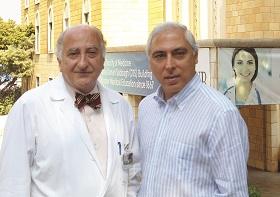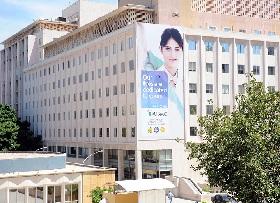Understanding longevity: From gene sequences to social inequity
03 April 2025
Published online 4 October 2012

The developing world is facing a major challenge in providing enough doctors and biomedical scientists to meet the needs of its people. The challenge is made more difficult by the migration of such a valuable workforce to wealthier Western countries after they qualify . In fact, up to 28% of physicians practicing in four of the richest countries, the United States, the United Kingdom, Canada, and Australia, graduated from medical schools based in a developing country .
This loss is restricting efforts by local, regional and international organizations to provide optimal health services in developing countries. We recently proposed that creating a regional network of medical centres of excellence in the Middle East and establishing collaborations with North American and European partners might be a fruitful approach for luring health workers back to their home country, and we contend that Lebanon could act as a hub .
Nearly 40% of all doctors who graduated from Lebanese medical schools over the past 25 years currently practice in the United States . Indeed, Lebanon has the highest physician emigration factor — the percentage of medical school graduates from a source country working in one of four major recipient countries — of all countries in the Middle East and North Africa, and the seventh highest in the world at an astounding 19.3 percent .
Regardless of which medical school they originally studied in, the estimated 3,100 Lebanese doctors currently practicing in the United States are often more likely to be engaged in research and affiliated with universities than doctors from other countries. In many cases, Lebanese graduates often go on to head academic departments, research laboratories and institutes in distinguished US medical organizations .
We set out a multi-staged approach for reversing the brain drain of Lebanese doctors and scientists from North America and Europe. Our plan is based on five rules and could be applied to any initiative to repatriate doctors to any other region or county:
Without a major investment in building, expanding, and upgrading of local infrastructures, attempts at repatriation will be futile.
The first step is to compile a reliable, robust database of qualified persons. There are many sources from which to gather this information, such as the American Medical Association, social media, alumni records and mailing lists, national and regional (in this case Lebanese and Arab) medical associations abroad and scientific societies. It took us several years to gather the data on Lebanese talent, which are continually updated and analyzed.
We conducted a survey of the immigrant doctors and scientists to determine their willingness to return home and understand their needs. What issues would influence their decision?
We published the results of our survey of Lebanese doctors and scientists. Out of 286 doctors surveyed, 61% were willing to relocate to Lebanon but only a third were willing to relocate to the Arab gulf. A little more than half of them were willing to relocate to Lebanon as a base for clinical missions to the gulf. Our findings suggest that the proposal of making Lebanon a regional 'academic hub' by recruiting Lebanese medical graduates practicing in the US is feasible. More doctors were willing to move to Lebanon as a base for a job in the Arab Gulf region than those willing to relocate directly to one of the Gulf States.
Inadequate local resources are the main reasons doctors emigrate from developing countries. Thus, without a major investment in building, expanding, and upgrading of local infrastructures in medicine and healthcare delivery, attempts at repatriation will be futile. If academic institutions hope to lure physicians and scientists back to Lebanon, a major overhaul of local capacity to absorb recruits and to upgrade and modernize their basic and clinical research capacities is essential.
Resources for this upgrade can come from private foundations, philanthropy and governmental and international organizations. For instance, the American University of Beirut (AUB) embarked on an approximately US$500 million project, known as the AUBMC 2020 Vision, aimed at modernizing and expanding its medical education, research, and clinical facilities in the capital. In doing so, the university hospital will almost double its number of beds and grow the size of its medical class to 120 students but not without the construction of new facilities. The AUB will also expand its education and research programmes by creating several new centres of excellence in cancer, heart and vascular disease, neuroscience, genetics, and other major diseases that place a substantial burden on the people of the Middle East. In parallel, other medical institutions in Lebanon have been expanding and renewing their clinical and research capacities to various extents, including a new medical school at the Lebanese American University, Beirut, which opened in 2009.
An immediate benefit of the return of this talent pool is the introduction of the latest advances in medical science and interventional medicine.
Besides increasing local capacity, the sustained effort to repatriate doctors and scientists depends on the establishment of a robust programme of collaboration in education, research and clinical study with health institutions and medical schools across the region.
Since 2009, seven such agreements have been signed between partners in the region. The ultimate objective is repatriating as many Lebanese medical and research graduates as possible by providing them with career opportunities across the region.
Returning scientists and doctors need to maintain those close and active relationships with academic and research institutions in the West from whence they came. This is important to sustain standards of excellence and peer review and best scientific and medical practice. It also helps provide opportunities to local graduates in pursuing specialist study in Western universities and laboratories. This can bolster local capacity building until the time where local capacity is self-sustaining.
The increased interest of Western academic institutions in affording a global health perspective to their students and researchers means such links become of mutual interest to both parties. To this end, the medical school at the Lebanese American University has a collaborative relationship with Harvard Medical International and the AUB has signed 21 agreements with US and European universities since 2009.
Since 2009, we have begun to implement this programme at AUB. Over the past three years, over 80 doctors and scientists returned to Lebanon to join the ranks of the AUB Faculty of Medicine and work at our medical centre. This unprecedented reversal of the brain drain of Lebanese physicians and biomedical scientists is quite significant. The ages of returning doctors range between 31–61 years, the majority being in the junior faculty ranks (15% instructors; 55% assistant professors) with a significant number of more senior professors (15% associate and 15% professors).
This data demonstrates that both young and more seasoned doctors and PhD scientists are willing to commit their future and the future of their families to Lebanon. It also attests to the fact that we have managed to build up the academic and business infrastructures needed by researchers before they consider moving back home. In addition, over this time, less than 10% of those researchers who returned to Lebanon moved back to North America.
Although the majority of returnees are AUB graduates, a number of graduates from other Lebanese medical schools, such as Saint Joseph University in Beirut and the Lebanese University, have joined the AUB medical faculty. While the vast majority of recruits are men (80%), an encouraging number of females initiated their return to Lebanon.

An important demographic is the geographic distribution of returning doctors/scientists within Lebanon: 30% indicate Beirut as their city of residence, while 20% live in north Lebanon, and about 15% hail from the South, the Bekaa, and Mount Lebanon. This shows that the rewards of having young Lebanese health professionals return to Lebanon are not limited to the relatively wealthier communities of Beirut and Mount Lebanon, but extend to the entire country. Interestingly, analysis of the religious affiliations of returnees reveals that almost half are equal Christians and the other half are Muslims.
Importantly, the institutions of origin from which recruits have returned rank among the top in the world and the quality of the recruited individuals, as evidenced by their academic records and objective criteria, reach the highest tiers of their fields. An immediate tangible benefit of the return of this talent pool is the introduction of the latest advances in medical science and interventional medicine (some being a first in Lebanon and the region). This, in turn, has enabled AUB medical centre to strengthen its mission to train outstanding medical professionals and scientists from Lebanon and the region under the strict international accreditation standards of its undergraduate and postgraduate training programmes.
In attracting doctors and biomedical scientists of all social, geographic and economic backgrounds back to Lebanon, we have begun to stem the hemorrhage of our home-grown talent from Lebanon. As events reshape the political and social realities of the region, the reversal of the exodus of talent in science and medicine presents a concrete validation of a systematic step-wise approach, which we propose as a successful model for other countries in the region, and for countries in other regions suffering from global disparities in quality healthcare education and delivery.
doi:10.1038/nmiddleeast.2012.143
Stay connected: